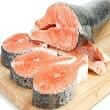Background
- Astaxanthin is classified as a xanthophyll, which is a carotenoid pigment, and can be found in microalgae, yeast, salmon, trout, krill, shrimp, crayfish, crustaceans, and the feathers of some birds. Haematococcus pluvialis, a green microalga and one of the richest sources of natural astaxanthin, was reviewed and cleared for marketing by the United States Food and Drug Administration (FDA) in August 1999 as a new dietary ingredient by means of the Dietary Supplement Health and Education Act (DSHEA) (21 CRF part 190.6).
- Astaxanthin is most commonly used as an antioxidant and may be beneficial in decreasing the risks of certain chronic diseases, such as cancer and cardiovascular diseases. Astaxanthin may also be effective in carpal tunnel syndrome, rheumatoid arthritis, muscle strength and endurance, high cholesterol (LDL oxidation), musculoskeletal injuries, and male infertility.
- Astaxanthin has been used as a feed supplement and food coloring additive for salmon, crabs, shrimp, chickens, and egg production. According to the Code of Federal Regulations, astaxanthin is generally recognized as safe (GRAS) when used as a color additive in salmon foods to obtain the desired pink to orange-red color.
References
- Anderson ML. A preliminary investigation of the enzymatic inhibition of 5alpha-reduction and growth of prostatic carcinoma cell line LNCap-FGC by natural astaxanthin and Saw Palmetto lipid extract in vitro. J Herb.Pharmacother. 2005;5(1):17-26.
View Abstract - Bertram JS, Vine AL. Cancer prevention by retinoids and carotenoids: independent action on a common target. Biochim.Biophys.Acta 5-30-2005;1740(2):170-178.
View Abstract - Bloomer RJ, Fry A, Schilling B, et al. Astaxanthin supplementation does not attenuate muscle injury following eccentric exercise in resistance-trained men. Int J Sport Nutr Exerc Metab 2005;15(4):401-412.
View Abstract - Chew BP, Park JS. Carotenoid action on the immune response. J Nutr 2004;134(1):257S-261S.
View Abstract - Comhaire FH, El Garem Y, Mahmoud A, et al. Combined conventional/antioxidant "Astaxanthin" treatment for male infertility: a double blind, randomized trial. Asian J Androl 2005;7(3):257-262.
View Abstract - Coral-Hinostroza GN, Ytrestoyl T, Ruyter B, et al. Plasma appearance of unesterified astaxanthin geometrical E/Z and optical R/S isomers in men given single doses of a mixture of optical 3 and 3'R/S isomers of astaxanthin fatty acyl diesters. Comp Biochem Physiol C.Toxicol Pharmacol 2004;139(1-3):99-110.
View Abstract - Daubrawa F, Sies H, Stahl W. Astaxanthin diminishes gap junctional intercellular communication in primary human fibroblasts. J Nutr 2005;135(11):2507-2511.
View Abstract - Hussein G, Nakamura M, Zhao Q, et al. Antihypertensive and neuroprotective effects of astaxanthin in experimental animals. Biol Pharm Bull 2005;28(1):47-52.
View Abstract - Hussein G, Sankawa U, Goto H, et al. Astaxanthin, a carotenoid with potential in human health and nutrition. J Nat Prod 2006;69(3):443-449.
View Abstract - Lockwood SF, Gross GJ. Disodium disuccinate astaxanthin (Cardax): antioxidant and antiinflammatory cardioprotection. Cardiovasc.Drug Rev 2005;23(3):199-216.
View Abstract - Mason RP, Walter MF, McNulty HP, et al. Rofecoxib increases susceptibility of human LDL and membrane lipids to oxidative damage: a mechanism of cardiotoxicity. J Cardiovasc.Pharmacol 2006;47 Suppl 1:S7-14.
View Abstract - Nir Y, Spiller G, Multz C. Effect of an astaxanthin containing product on carpal tunnel syndrome. J Am Coll Nutr. 2002;21:489.
- Nir Y, Spiller G, Multz C. Effect of an astaxanthin containing product on rheumatoid arthritis. J Am Coll Nutr. 2002;21:490.
- Teo IT, Chui CH, Tang JC, et al. Antiproliferation and induction of cell death of Phaffia rhodozyma (Xanthophyllomyces dendrorhous) extract fermented by brewer malt waste on breast cancer cells. Int J Mol Med 2005;16(5):931-936.
View Abstract - Vine AL, Bertram JS. Upregulation of connexin 43 by retinoids but not by non-provitamin A carotenoids requires RARs. Nutr Cancer 2005;52(1):105-113.
View Abstract







